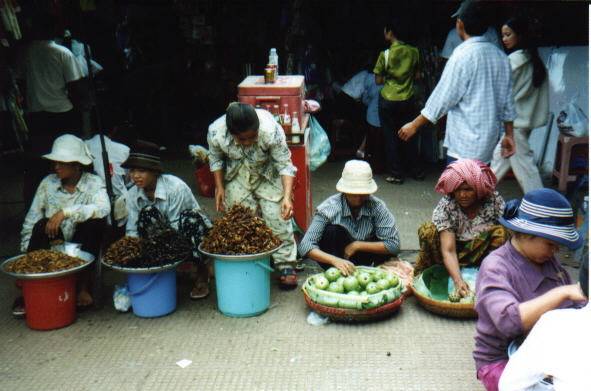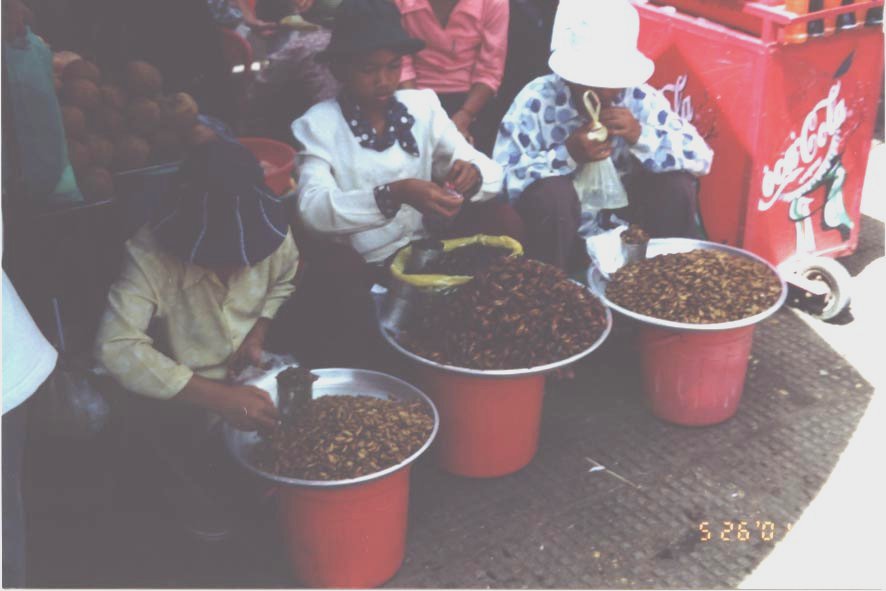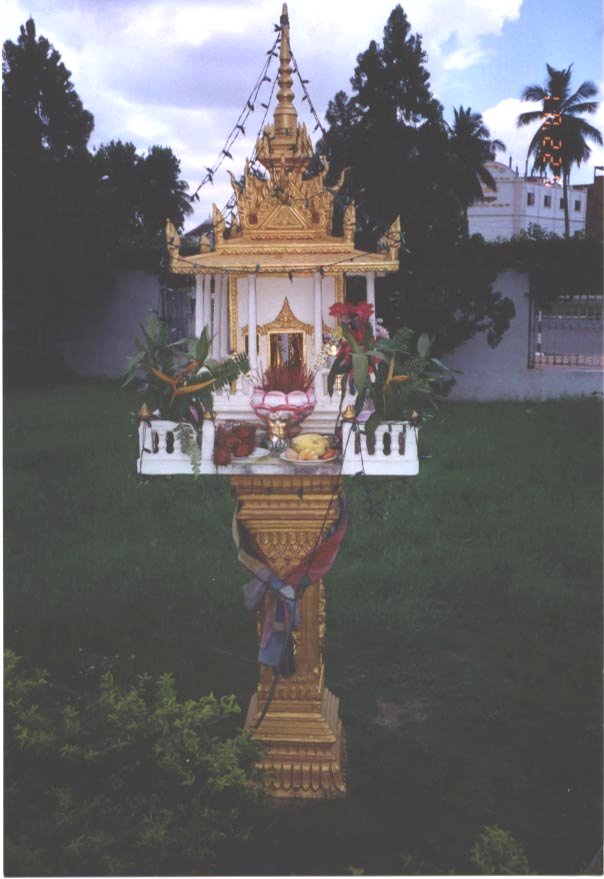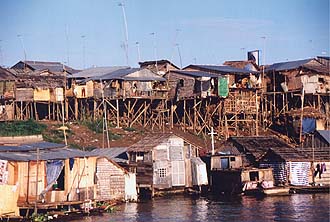Cambodia�an
Overview
Geography
Cambodia
covers an area of some 181, 035 square km (slightly smaller than Oklahoma) and
is bordered by Thailand to the West, by Vietnam to the East, by Laos to the
North, and by the Gulf of Siam to the South.�
The country�s terrain mostly consists of low and flat plains, which
are fertile thanks to the Mekong and Tonle Sap rivers.�
Highlands and mountains surrounded by evergreen forests can be found in
the North and South of the country.� The
Mekong and Tonle Sap rivers merge in Phnom Penh, forming a wonderfully unique
site for celebrating cultural and social activities throughout the year.�
The Tonle Sap River is the only river in the world that has a current,
which changes direction depending on the time of year.�
Cambodia hosts three mountain ranges:�
The Dangreks to the North, the Cardamoms to the NE, and the Elephant
Mountains to the South.� These
mountains benefit the Kingdom a great deal.�
They provide a secure habitat for many rare animals as well as species
of tropical trees, streams, and waterfalls.�
�
The People��
�
The
population of Cambodia is around 12.5 million people.�
Of those, 90% are of ethnic Khmer heritage.�
The remaining 10% of the population is made up of Vietnamese (5%),
Chinese (1%) and other small minority groups (4%).�
Cambodia is a largely agrarian nation�80% of its people spend their
lives farming.� The Vietnamese are
known for being skilled workers and the Chinese dominate business ownership.�
In general, the Cambodian people are kind and welcoming to Americans
who visit their country.
�The
Language�
�
|
|
|
"Thank You" in Khmer |
The
Cambodian language is Khmer (pronounced K�mai, as in �my� dog).�
The Khmer language was derived from the Indic languages of Pali and
Sanskrit from India.� The Khmer
language of today shares many characteristics with written and spoken Thai.�
Some technical terms are borrowed from the French.�
However, English is commonly communicated in hotels and business
compounds at present day.� Almost
all Khmer have at least a very basic vocabulary of English.�
�
Climate�
Situated
in a tropical zone, Cambodia is bathed in sun almost all year around.�
There are two main seasons:� the
rainy season and the dry season.� Each
season brings about refreshing change.� The
humid, rainy season lasts from April to November.�
During the monsoon season temperatures generally range from 81- 95
degrees Fahrenheit.� The hottest
month is April when the temperature can reach above 106 degrees Fahrenheit.�
The cool, dry season lasts from December to March, with temperatures
ranging from 63 � 81 degrees Fahrenheit.�
Local Cuisine�
Rice
and fish are the main staples in the Cambodian diet.�
Rice is eaten fried, steamed, or in the form of noodles.�
Fish is eaten fresh, dried, or salted.�
Beef, chicken, and Pork are eaten on special occasions.�
Seasonings include hot peppers, lemon grass, ginger, and mint.�
There are a plentiful variety of exotic fruits that are incorporated
into the diet as well.� Some of
these fruits are Coconut (very important in many Khmer dishes), Dragon Fruit,
Bananas, Durian (a national favorite) and Angkunh Fruit.�
Tea is the National drink and Betel nuts are often chewed in much the
same way tobacco is chewed in other countries.�
Local specialty dishes include: Prahoc, a lightly spiced and
fermented fish paste; Nhaom, a popular dish comprised of vinegar, dried
fish, herbs and vegetables; Kor Kor, cooked with fish and a mix of
vegetables; Amok, fish cooked in coconut; and Samlor Machu,
vinegar soup cooked with fish and mixed with a variety of vegetables.�
Chinese and Western menus are commonly available in the cities of Phnom
Penh, Siem Reap, and Sihanoukville.�
�
Religion�
Theravada
Buddhism is the official religion of Cambodia and is practiced by 95% of the
population.� [Theravada Buddhism
is also the predominating religion in Thailand, Burma, and Sri Lanka.]�
However, Christianity and Cham Muslim groups are active and growing
among large numbers of people in the cities.�
Daoism and Confucianism are also commonly practiced among the Chinese
people in Cambodia.
|
A
typical Phnom Penh |
|
 |
|
|
A
"Spirit House" on the grounds |
|
Society�
The
Khmer society places great importance on family.�
Khmer families consist of a husband, a wife, and their unmarried
children.� The husband is the head
of the family, but the wife is expected to take care of the financial matters
in the home.� In rural areas men
and women�s work is divided.� Children
receive a great deal of freedom and affection.�
They are taught to show respect toward their elders and Buddhist monks.�
Children are supposed to memorize the Chbap, a collection of
moral proverbs.� Every village has
a Wat, a Buddhist temple.� Most
Cambodian males become Buddhist monks for about six months to a year, usually
at the age of sixteen.� In the
villages parents often choose their children�s spouses.�
A representative investigates each side for good social and economic
standing.� The wedding ceremony
follows the Buddhist tradition.�
Many Cambodians believe in charms to ward off evil.
�Dress�
Traditional
Khmer dress consists of a white shirt or blouse and a knee-length sarong.�
Farmers wear a collarless black shirt and baggy trousers.�
A long checkered scarf, or Krama, is often worn around the head.�
Today most Khmer people wear Western-style pants and shirts, although
traditional clothing is still seen as well.
�

Clockwise from top left:� Sampot Chang Kben (skirt rolled in front and pulled up to waistband in back, common attire); Dressy attire including "temple sashes"; Royal and/or Wedding Attire.
�Housing�
|
Houses on the Tonle Sap River - � Manfred Leiter |
Most
village houses are built on stilts to avoid rising water resulting from
torrential monsoon rains.� Sugar
palm trees are used for building the walls and roofs of the rural houses.�
Walls are made of woven bamboo and the floors are made of wooden
planks.� A smaller house may
consist of only one room with no windows.�
Most Khmer houses have a statue of Buddha; the furniture is usually
simple and practical.� Some houses
use mosquito netting as protection while sleeping.�
Cooking is done in a separate kitchen near the house.�
Livestock and farming equipment are kept in the space under the stilts
of the home.� Urban houses are
several stories high and are made of brick, masonry, or wood�resembling
western apartment buildings.
�
Sports
and Recreation�
Most
Cambodian festivals are associated with either the agricultural cycle or with
Buddhism.� The Water Festival or
Festival of the Reversing Current, is perhaps the most joyous holiday of the
year.� Many boat races are held
for three days.� Music is the most
popular art from in Cambodia.� Popular
instruments are drums, flutes, gongs, violins, and wooden xylophones.�
The stylized Romwong (also spelled Ramvang) is the national dance.
�Communications�
The
government publishes around 15 daily newspapers, mostly in the Khmer language.�
As of the early 1990�s there was one radio per 36 persons, one
television set per 141 persons, and one telephone per 790 persons.�
It is expected that those numbers have increased dramatically in recent
years.� Because land telephone
lines are still somewhat unpredictable, many people are now choosing to use
only cellular phones�especially in larger cities such as Phnom Penh and Siem
Reap.�
Health�
One
of the major health problems in Cambodia is the lack of sanitation.�
Water-born diseases such as hepatitis are common.�
Other widespread diseases are pneumonia and tuberculosis.�
There is a shortage of trained medical personnel, as the Khmer Rouge
murdered most of the country�s doctors and nurses in the 1970�s.�
Land mines still pose a major problem for people who live in rural
areas.� Some estimates suggest
that as much as 1/3 of the population has been maimed or killed by a land mine
in the last 30 years.� However,
land mines have now been cleared in the major cities and on most major
highways.� The life expectancy is
now up to 56 years for the general population.�
The infant morality rate is at 6.5%.
�Education�
Primary
education is compulsory for six years, between the ages of 6 and 12.�
Children go to school in either the early session or the late session
for six days a week.� The early
session runs from 7:30am-11:30 am and the late session runs from
1:00pm-5:00pm.� Secondary
education is comprised of two cycles; the first lasting four years, and the
second lasting two years.� Prince
Norodom Sihanouk greatly expanded Cambodia�s school system, which was wiped
out by the Khmer Rouge.� The
country still suffers from a high percentage of adult illiteracy. High schools
and colleges suffer from chronic shortages of textbooks, laboratories, and
equipment.� Only 35% of the adult
population was able to read and write as of 1990.�
�
�
�
Information collected by Anita Gillispie from various websites and the CIA World Fact Book 2001.� Click on images to enlarge.
�







